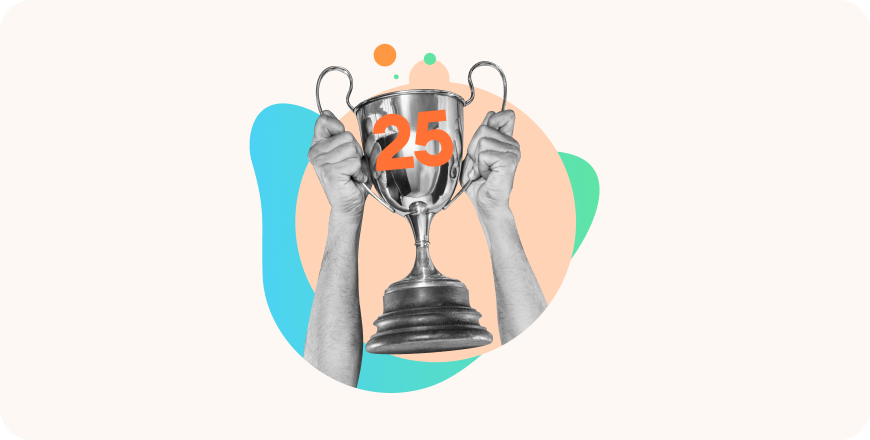LMS Integration: Definition, Benefits, and Real Examples

Organizations today rely on a staggering number of software systems — on average, 112 different SaaS applications per day, from HR and payroll systems to CRM collaboration tools.
Without seamless integration, these systems operate in silos, leading to manual data entry, inefficiencies, and disconnected workflows. When it comes to corporate training, a learning management system (LMS) that integrates with your existing tech stack can save administrators time, streamline business operations, and prevent scattered or inconsistent data.
In this article, we’ll cover everything you need to know about LMS integration, including what it is, the main types of LMS integrations, and how you can benefit from it.
What Is LMS Integration?
LMS integration is your learning management system’s ability to share data with other corporate software used in your organization. Integrating these systems enables your business to automate manual processes and consolidate valuable data from other apps to give you an overall view of training activities in the company. As a result, L&D and HR teams can simplify their workflows, deliver a better learning experience, and take action based on deeper business insights.
Benefits of Learning Management System Integrations
An LMS has become an essential corporate tool. And it should fit with the existing tools in your tech stack, allowing for a more streamlined working process.
Here are the key benefits of LMS integration:
- Eliminates administrative inefficiencies. Automating data exchange between systems reduces duplicate work, saving L&D teams valuable time on repetitive tasks.
- Better user adoption. Integrating an LMS with familiar workplace tools makes it easier for employees to engage with training, encouraging higher participation rates.
- Shorter learning curve. Employees can continue using their familiar tools for training, eliminating the need to adapt to an entirely new system.
- Enhanced compliance management. LMS integration with third-party auditing tools can automatically feed employee training records into compliance dashboards, helping businesses meet industry regulations effortlessly.
- Aligning learning with business goals. Connecting your learning management system with an HR and CRM tech stack enables data-driven training decisions, such as assigning learning materials based on sales performance metrics.
- Improved team collaboration. Syncing LMS platforms with communication tools (e.g., Slack, Microsoft Teams) improves the learning experience.
- Data-driven decision-making. The more systems your learning management system connects with, the richer the insights you gain from training analytics. These insights enable better performance tracking and more accurate ROI measurement.
Also read:
Types and Examples of Integrations for Learning Management Systems
When it comes to LMS integration, the goal is to find a learning platform that aligns with your business needs. Let’s explore the most common LMS integration examples based on iSpring Learn — the leading learning platform for corporate training.
1. Video conferencing
Almost every business on the planet uses some kind of video conferencing software. In fact, half a million companies use Zoom.
Zoom LMS integration enables you to organize virtual classrooms and group learning meetings directly within the learning portal.
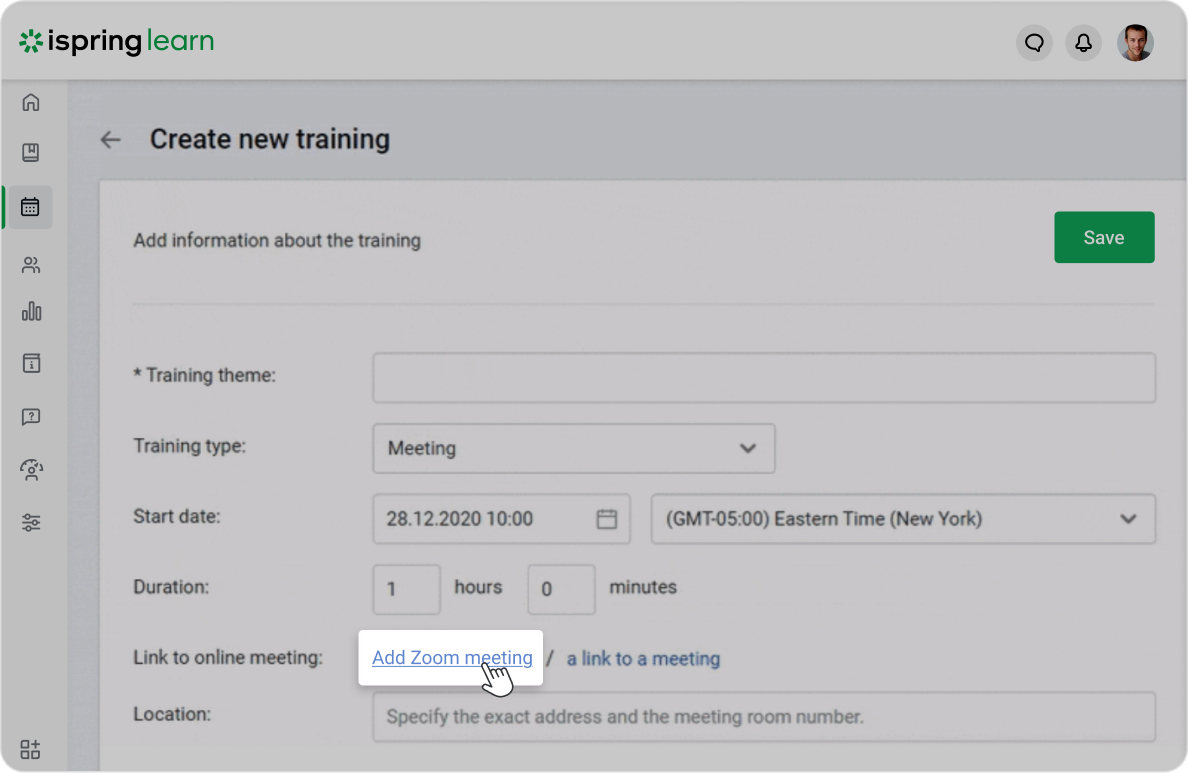
How does it work?
Integrating your learning management system (LMS) with video conferencing software transforms your LMS into a unified communication platform. This is especially useful for delivering blended learning.
For example, the iSpring Learn LMS integrates with Zoom, Microsoft Teams, and Courseboost video conferencing tools. This allows you to set up virtual meetings and online training sessions with your employees from within the LMS platform. Learners can access VILT sessions directly from the LMS calendar, while you can monitor their participation in live meetings through comprehensive LMS reports.
iSpring Learn LMS
Automate corporate training and improve employee performance.
2. CRM
Customer Relationship Management tools, or CRMs, allow companies to streamline sales, improve customer service, and enhance decision-making with real-time customer data insights. Popular CRM platforms like Salesforce, HubSpot, and Microsoft Dynamics help organizations keep track of leads, manage accounts, and personalize customer learning experiences.
If your learning management system has a Salesforce integration, for example, you can:
- Track employee training directly within the CRM to ensure that sales and customer support teams have the necessary knowledge.
- Assign relevant training based on CRM data, such as customer interactions or product updates.
- Improve sales enablement by equipping teams with real-time education opportunities to close deals more effectively.
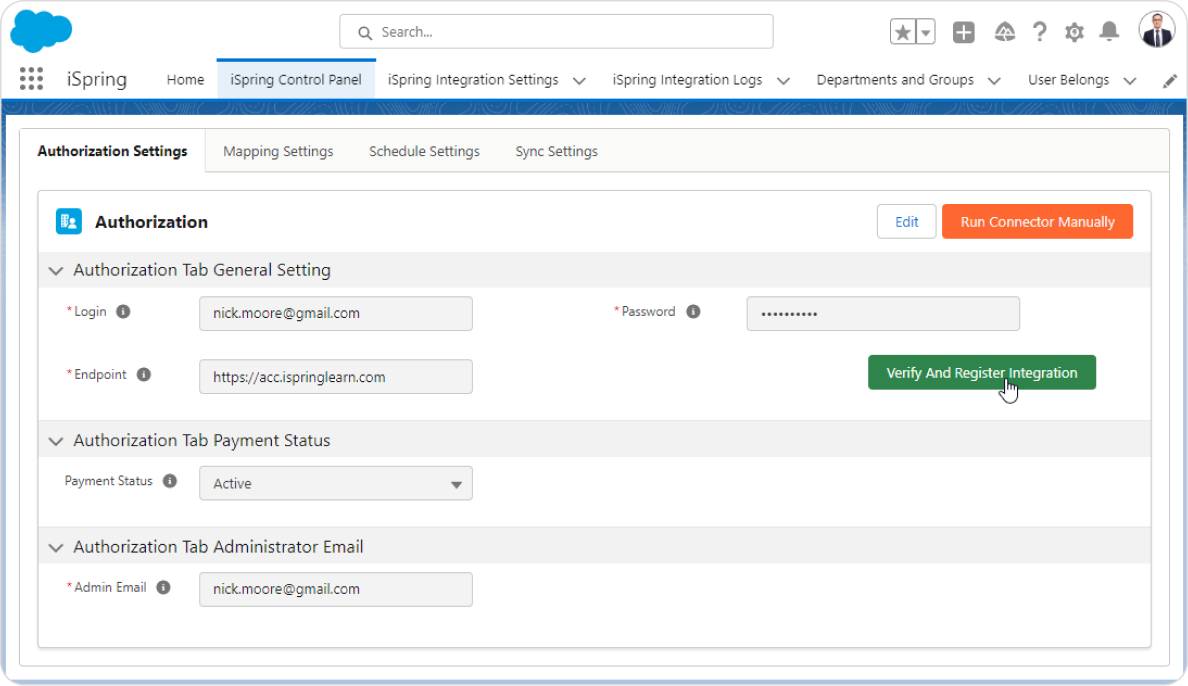
How does it work?
With the iSpring Learn LMS integration with Salesforce, you can manage sales training within Salesforce, including assigning online courses, grouping users, and pulling training reports. As such, you no longer have to toggle between two systems. What’s more, you can automate the transfer of information (user profiles, training progress, etc.) between the tools. Organizations that run training for external partners and customers will find CRM integration especially useful.
Also read: Salesforce Integration with iSpring Learn →
3. eCommerce
An LMS ecommerce integration with Shopify is a must if your organization plans to monetize training courses on its LMS.
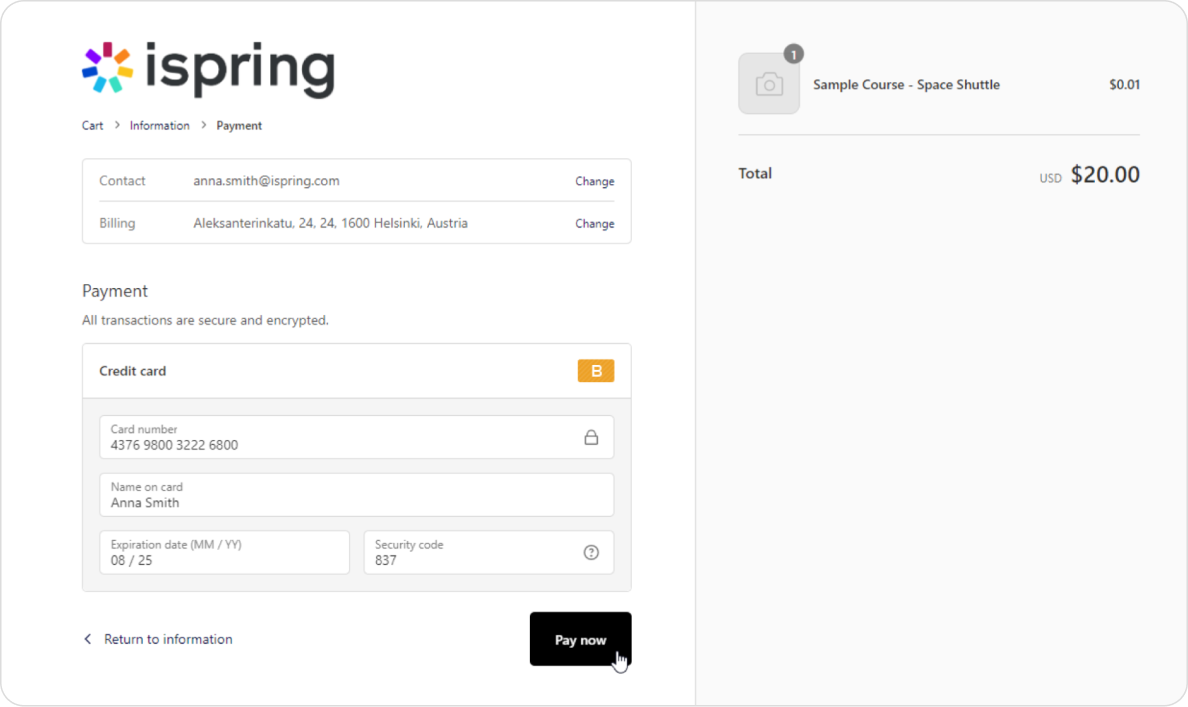
How does it work?
The iSpring Learn LMS integration with Shopify allows you to easily monetize your training programs by selling them through iSpring Learn. Promote courses on the Internet, connect payment services, and automate all routine tasks. When your courses are purchased from the Shopify store, iSpring Learn automatically enrolls users in training.
4. HRIS
With an HRIS (Human Resource Information System), HR teams manage employee data, automate administrative tasks, and streamline workforce processes, such as hiring, payroll, benefits, and performance tracking.
An LMS HRM (Human Capital Management) integration creates a powerful synergy, ensuring that employee training and HR records remain perfectly aligned. With iSpring Learn, you can integrate with BambooHR, OrangeHRM, and PeopleWeek seamlessly.
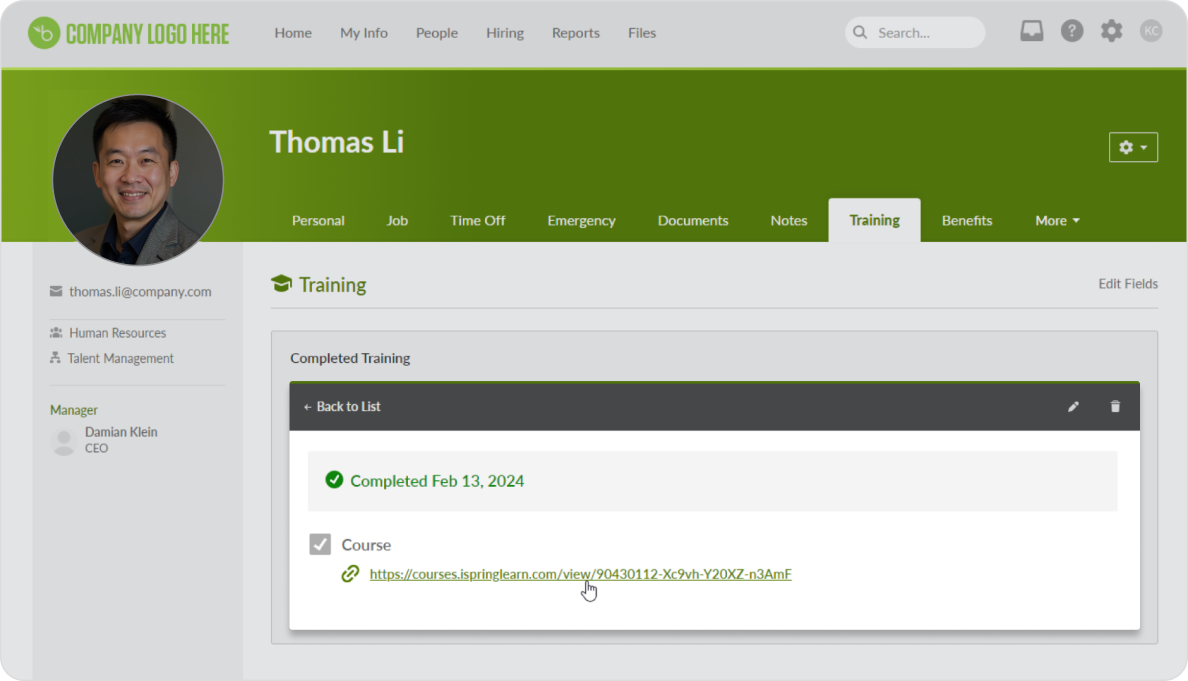
How does it work?
With iSpring Learn’s integration with BambooHR, all employee data stays synchronized between your HR system and LMS, ensuring a smooth and automated training process.
For example, when a new hire is added to the HRIS, their details are automatically sent to iSpring Learn, triggering immediate enrollment in required training (e.g., onboarding, compliance, or job-specific courses). If an employee leaves the company, their LMS account is automatically deactivated, eliminating the need for manual updates.
As employees change roles or receive promotions, iSpring Learn updates their training assignments based on their new responsibilities, keeping them up to date with required skills and certifications.
Another integration with OrangeHRM is perfect for aligning data during the hiring process. For candidates in the hiring pipeline, training can be assigned based on recruitment stages. For example, a candidate moving from the application phase to onboarding can be automatically enrolled in pre-hire training, ensuring they’re prepared for their first day in the company.
5. eLearning libraries
LMS content integration opens up vast learning opportunities for employees. In addition to creating courses from scratch, organizations can provide their teams with access to high-quality, ready-made training materials that cover a wide range of topics, from soft skills to technical expertise.
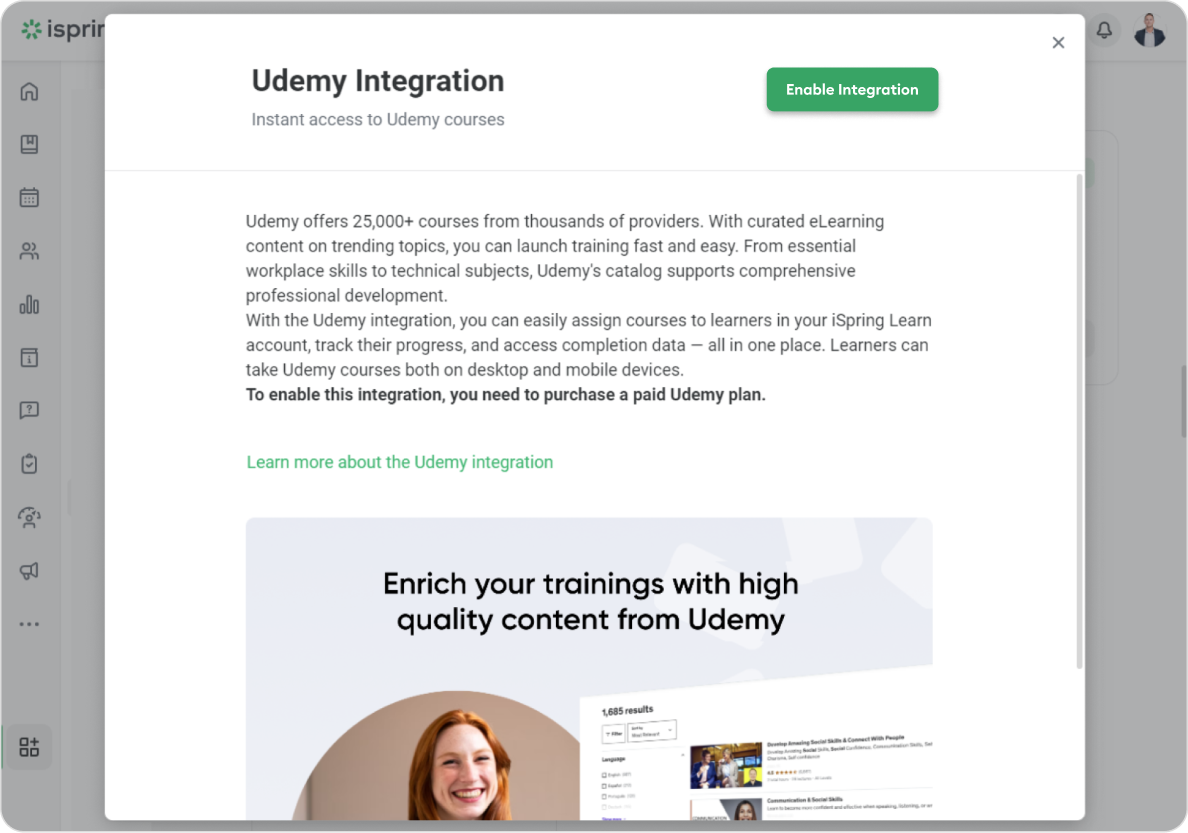
How does it work?
With iSpring Learn, you can integrate with leading eLearning providers seamlessly, ensuring that access to training resources, completion tracking, and reporting happen within a single learning platform. To date, you can integrate this LMS with three eLearning libraries:
- Go1 — one of the largest eLearning content aggregators, offering 100,000+ courses from over 250 providers.
- LinkedIn Learning — a vast selection of 5,000+ professional courses, offering personalized recommendations based on learner preferences and career goals.
- Udemy — a global marketplace with an extensive, multilingual course library taught by real-world experts.
These LMS integrations give organizations instant access to high-quality, expert-led courses without the need for extensive in-house content creation. Learners don’t have to switch between different platforms to take courses — everything can be accessed through the iSpring Learn LMS, and all training data is conveniently reflected in the LMS reports.
6. Calendars
Keeping track of training sessions, deadlines, and learning events can be challenging, especially in a busy work environment. That’s where calendar integrations come in!
An LMS integration with a popular calendar app, e.g., Google Calendar and Outlook, allows learners and administrators to automatically sync training schedules, ensuring they never miss an important session.
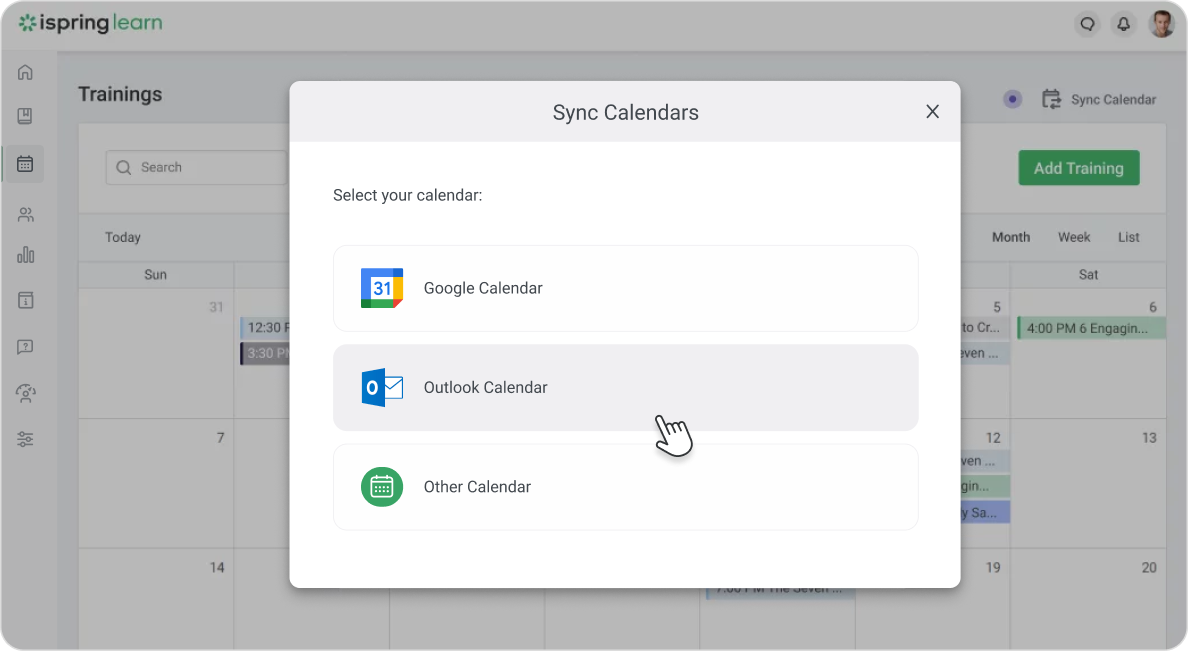
How does it work?
Calendar integrations in iSpring Learn make it easy for learners and administrators to stay on top of training schedules. When a webinar or training session is scheduled, it automatically syncs with the learner’s Google Calendar or Outlook, ensuring they have all their training commitments in one place. This eliminates the need for constant reminders or checking the LMS for upcoming sessions, because everything appears in their familiar calendar app.
For live sessions, such as Zoom or Microsoft Teams webinars, learners can join directly from their calendar event with a single click.
7. Single sign-on (SSO)
Remember we mentioned that the average company has 254 SaaS applications? Well, that isn’t just an issue with user adoption. It can also be a security risk.
Log-in credentials are fodder for hackers. That means every time an employee logs in to one of these apps, there’s a security risk. LMS integration with single sign-on does a lot to reduce this risk.
Employees don’t have to constantly enter their log-in details. If they’re signed in to your corporate website or email server, iSpring Learn authenticates them automatically. For example, you can integrate iSpring Learn with AZURE AD and Active Directory.
How does it work?
It simplifies the log-in process, so employees don’t need to enter their credentials every time they open a corporate app. Instead, they log in once and have permission to enter all corporate business applications. This reduces security risks and boosts usability.
For instance, iSpring Learn LMS integrates with AZURE AD and Active Directory. That way, when an employee signs into the corporate website or server, iSpring automatically authenticates them.
Learn more about the iSpring Learn integrations →
8. LTI integration
Your LMS should be right at the heart of your organization’s eco-system, especially if you want to foster a learning culture. As a result, Learning Tools Interoperability (LTI) is an extremely powerful LMS integration to consider.
This is an industry standard that was designed to connect external apps with learning management systems so LMS users can send and receive data between different learning tools. Put simply, it ensures that your LMS is communicating with the external apps in the same language.
How does it work?
The main idea is that apps developed using the LTI standard can integrate easily with any LMS that supports that standard. It syncs your LMS with any external system (HR, ERP, employee portals, BackOffice tools, etc.) seamlessly.
For example, an LMS with LTI integration can host training content from third-party providers on a website. Learners don’t have to log in to external systems separately because the LMS automatically shares users’ information with the other platform. The end result is more cohesive, effective training and an enhanced user experience.
FAQ on LMS Integration
Check out the most common questions answered about LMS integration:
What are the challenges regarding LMS integration?
LMS integration can bring many benefits, but it also comes with challenges:
- Compatibility is a common issue, as not all third-party tools are designed to work seamlessly with every LMS, requiring custom API development or middleware solutions.
- Data synchronization errors can also occur if systems don’t update in real time or if there are inconsistencies in how data is structured.
- Employee data security risks are another concern, as integrating multiple systems increases the need for strong data protection measures, such as encryption and access controls.
- Setup complexity — some integrations require IT expertise, especially when dealing with APIs or custom configurations.
- System performance can be affected if too many integrations run simultaneously without proper optimization.
Careful planning, testing, exploring best practices, and ongoing monitoring can help organizations overcome these challenges and ensure smooth LMS integration.
What is an API, and how is API different from an LMS integration?
An API (Application Programming Interface) is a set of rules that allows different business systems to communicate with each other. API acts as a bridge, enabling data to be exchanged between an LMS and other tools, such as HR systems or eLearning content providers.
An LMS integration, on the other hand, is the actual connection between the LMS and an external system, which may or may not require an API. In simple terms, an API is the technology that makes integrations possible, but not all integrations require direct API usage: some are built-in and function automatically, while others need custom API development to connect different platforms.
Can I choose which data gets shared between my LMS and other systems?
Yes, most LMS platforms allow you to control which data is shared between your LMS and other systems. When setting up an integration, administrators can typically configure what information is exchanged, such as user profiles, course progress, completion records, or enrollment details. Some integrations offer preset data syncing options, while others provide customizable settings through APIs or advanced configurations.
Final Thoughts
LMS integrations align your online training platform with existing corporate tech stack to simplify business processes and centralize data. Besides providing a more seamless user experience, your organization can access essential data in a single place with ease. This results in more effective training that is in line with business goals.
If you’re looking for a powerful LMS with a wide range of integrations, why not try iSpring Learn? Book a free LMS demo today to learn how the platform can be beneficial and see it in action.
